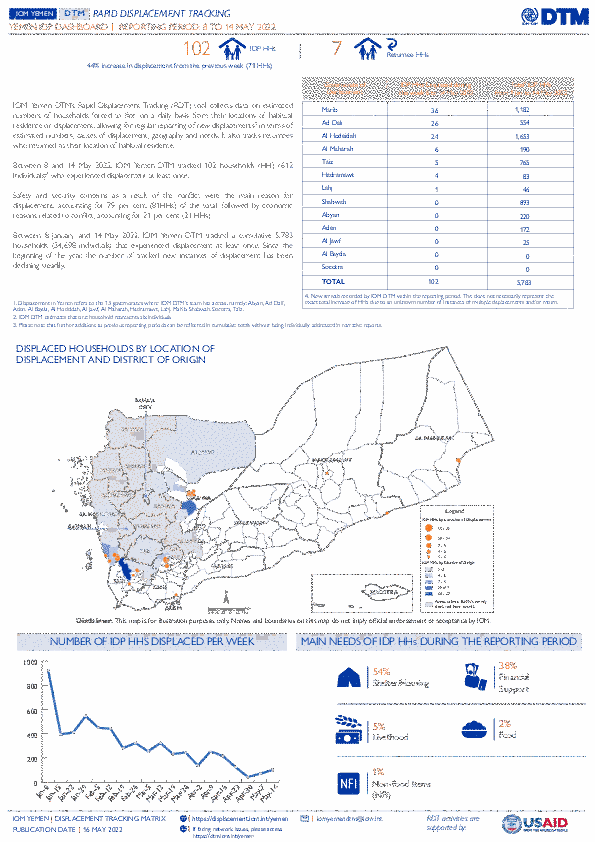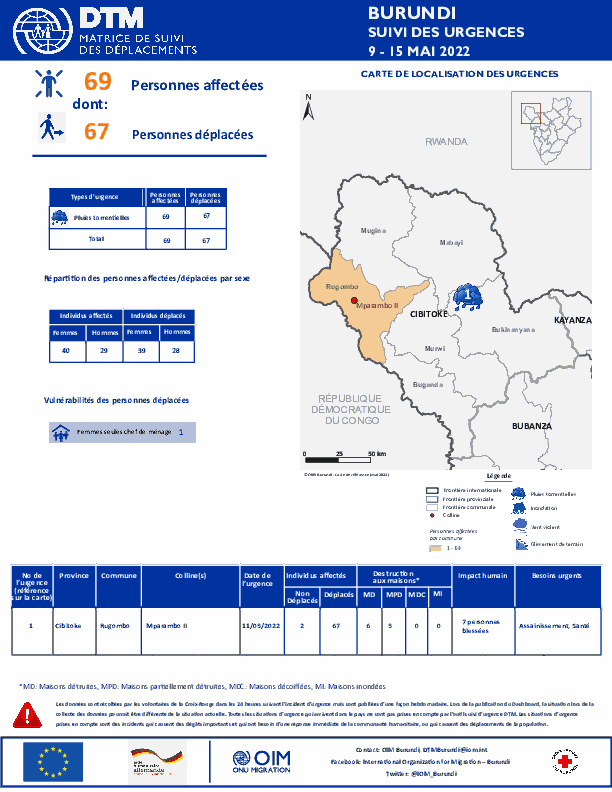-
Countries
-
Data and Analysis
-
Special Focus
-
Crisis Responses
This map displays the subset of IDPs who arrived at their counties in South Sudan from abroad, by period of arrival (Mobility Tracking Round 11, September 2021).

Contact
iomiranmedia@iom.int
Language
Persian
Location
Iran (Islamic Republic of)
Period Covered
Jan 01 2020
Dec 31 2021
Activity
- Flow Monitoring
این تصویر اجمالی، خلاصه ای از داده های موجود در مورد اتباع ایرانی در اروپا در سال ۲۰۲۰ و سال 2021 می باشد. صفحه اول، نمایانگر تعداد اتباع ایرانی وارد
شده از طریق مرز های زمینی و دریایی به اتحادیه اروپا و کسانی که از طریق بالکان غربی و اروپای شرقی در سال 2021 وارد اروپا شده اند، می باشد.
اروپا جمع آوری شده. 1 تعداد توقیف یا ثبت نام ها در منطقه IOM DTM اطلاعات مربوط به ورود و ترانزیت توسط مقامات ملی فرآهم گردیده است و سپس توسط
مرزی بالکان غربی و اروپای شرقی برای جلوگیری از شمارش مضاعف افرادی که از چندین کشور به قصد رسیدن به اروپای مرکزی و شمالی عبور می کنند، خلاصه
گزارش شده است، UNDESA نمی گردد. صفحه دوم و سوم تعداد اتباع ایرانی مقیم اروپا را در سال 2020 بر اساس جنسیت و منطقه واقع در اروپا را که توسط
نشان می دهد.
تحت عنوان “شواهد منطقه ای برای بررسی و تحلیل مهاجرت” )DTM( تصویر اجمالی مذکور، بخشی از خروجی های پروژه ماتریس رهگیری جا به جایی
تقویت فرمول بنابر شواهد و اجرای سیاست ها و برنامه های DTM REMAP که بودجه آن توسط اتحادیه اروپا فرآهم شده، می باشد. هدف ،)REMAP(
بشردوستانه و توسعه در زمینه مهاجرت و جابجایی در افغانستان، بنگلادش، جمهوری اسلامی ایران، عراق و پاکستان می باشد.

Contact
iomiranmedia@iom.int
Language
English
Location
Iran (Islamic Republic of)
Period Covered
Jan 01 2020
Dec 31 2021
Activity
- Flow Monitoring
This snapshot summarizes available data on Iranian nationals in Europe in 2021 and 2020. The first page visualizes the number of Iranian nationals who arrived by land and sea in the European Union and those who transited through the Western Balkan and
Eastern Europe region in 2021. The data on arrivals and transits is made available by national authorities and then gathered by
IOM DTM Europe.1 Numbers of apprehensions or registrations at the border in the Western Balkan and Eastern Europe region
are not summed up to avoid double counting of the same persons who transit through multiple countries in their intent to reach
Central and Northern Europe. The second and third pages shows numbers of Iranian nationals residing in Europe in 2020 by
gender and European region as reported by UNDESA.
The snapshot is part of the outputs of the EU-funded Displacement Tracking Matrix (DTM) project “Regional Evidence for Migration Analysis and Policy” (REMAP). The objective of DTM REMAP is to strengthen the evidence-based formulation and implementation of humanitarian and development policy and programming on migration and forced displacement in Afghanistan, Bangladesh, the Islamic Republic of Iran, Iraq and Pakistan.

Contact
DTM Yemen, iomyemendtm@iom.int
Language
English
Location
Yemen
Period Covered
May 08 2022
May 14 2022
Activity
- Rapid Emergency Registration
- Mobility Tracking
IOM Yemen DTM’s Rapid Displacement Tracking (RDT) tool collects data on estimated numbers of households forced to flee on a daily basis from their locations of origin or displacement, allowing for regular reporting of new displacements in terms of estimated numbers, geography, and needs. It also tracks returnees who returned to their location of origin.
From 1 January to 14 May 2022, IOM Yemen DTM tracked 5,783 households (HH) (34,698 Individuals) who experienced displacement at least once.
Between 8 and 14 May 2022, IOM Yemen DTM tracked 102 households (612 individuals) displaced at least once. The majority of people moved into/within the following governorates and districts:
- Marib (36 HHs) – Marib City (27 HHs), Marib (9 HHs) districts. Most displacements in the governorate originated from Marib and Al Hodeidah.
- Ad Dali (26 HHs) – Qatabah (14 HHs), Ad Dali (12 HHs) districts.Most displacements in the governorate originated from Ad Dali and Ibb.
- Al Hodeidah (24 HHs) – Hays (18 HHs), Al Khukhah (3 HHs), At Tuhayta (3 HHs) districts. Most displacements in the governorate originated from Taiz and Al Hodeidah.
The majority of people moved from the following governorates and districts:
- Al Hodeidah (29 HHs) – At Tuhayta (7 HHs), Al Khukhah (5 HHs), Al Jarrahi (5 HHs) districts.
- Marib (23 HHs) – Al Jubah (13 HHs), Madghal Al Jidan (6 HHs), Rahabah (2 HHs) districts.
- Taiz (21 HHs) – Maqbanah (15 HHs), Hayfan (2 HHs), Sharab As Salam (1 HHs) districts.

Contact
DTMMozambique@iom.int
Language
English
Location
Mozambique
Period Covered
May 04 2022
May 10 2022
Activity
- Mobility Tracking
- Event Tracking
During the reporting period (04 to 10 May 2022), a total of 76 movements were recorded - 28 returns (4,487 individuals), 29 arrivals (2,580 individuals), 16 departures (398 individuals), and 3 transits (249 individuals). The largest return movements were recorded in Muidumbe (3,878 individuals), Palma (371 individuals) and Macomia (158 individuals). The largest arrival movements were recorded in Macomia (2,319 individuals), and Nangade (237 individuals). The largest departure movement was observed in Nangade (285 individuals). The largest transit movement was observed in Mueda (249 individuals). Of the total population, 6 per cent of mobile groups were displaced for the first time, and 94 per cent of reported individuals have been displaced more than once prior to this movement.

Contact
DTM Europe, DTMMediterranean@iom.int
Language
English
Location
Republic of Moldova
Period Covered
Feb 24 2022
May 09 2022
Activity
- Flow Monitoring
- Migrants presence
Since 24 February 2022, an increasing number of persons fleeing from Ukraine to the neighbouring countries has been observed, as a result of the war in Ukraine.
This report is based on cumulative and daily registrations by the General Inspectorate for Border Police (GIBP) of Ukrainian refugees and third-country nationals (TCNs) entering from Ukraine the territory of the Republic of Moldova at all Border Crossing Points (BCPs), since 24 February 2022, and out them, on the numbers of those who exited the country towards Romania, towards Ukraine and by flight, as well as on number of those who are still present in the Republic of Moldova.

Contact
DTM South Sudan, SouthSudanDTM@iom.int
Language
English
Location
South Sudan
Period Covered
Apr 01 2022
Apr 30 2022
Activity
- Registration
- Flow Monitoring
- Mobility Tracking
- Site Assessment
Recognizing that there have been significant population changes since the last overall biometric registration / verification, IOM DTM conducts regular population counts to monitor population dynamics and displacement trends. This exercise shows that the actual number of persons currently living at Bentiu IDP Camp remains lower than the registered total.
As per April 2022 population count findings, the Bentiu IDP Camp population stands at 112,329 individuals (17,714 households) in 12,017 inhabited shelters (on average 9 individuals per shelter). This represents a four per cent increase (4,939 individuals/834 households) compared to January 2022.

Contact
DTM Sudan; dtmsudan@iom.int
Language
English
Location
Sudan
Snapshot Date
May 11 2022
Activity
- Mobility Tracking
- Event Tracking
The DTM Emergency Event Tracking (EET) is deployed to track sudden displacement and population movements, provide more frequent updates on the scale of displacement, and quantify the affected population when needed. As a subcomponent of the new Mobility Tracking methodology in Sudan (Round Three), and activated on a need basis, EET utilises a broad network of key informants to capture best estimates of the affected population presence per location – a useful tool for humanitarian response planning and design.
Contact
DTM Yemen, iomyemendtm@iom.int
Location
Yemen
Activity
- Flow Monitoring Survey
- Flow Monitoring
- Mobility Tracking
Period Covered
Apr 01 2022 -Apr 30 2022
In April 2022, IOM Yemen DTM recorded 5,212 migrants entering Yemen, similar to 5,354 in March 2022. Thie relatively lower migration flow, in comparison to previous months, is likely related to seasonal changes including difficult weather conditions and high tides. Furthermore, the drop might also be associated with the tightening of security measures on the borders of Djibouti and Yemen.
Due to the deteriorating humanitarian crisis in Yemen and the challenges in moving towards KSA, many migrants opted to return to the Horn of Africa. DTM teams in Djibouti recorded that during April 2022, a total of 559 migrants took the risky return by boat from Yemen to travel home. Moreover, DTM recorded 5,898 Yemeni returns from KSA during the month of April 2022, compared to 7,607 in March 2022.
Between 1 January and 30 April 2022, an estimated 24,864 migrants and 23,950 Yemeni migrant returnees arrived in Yemen.
The migrant caseload was around 90 per cent Ethiopian nationals, and around 10 per cent Somali nationals. The migrants are predominantly male (67%), with (22%) women, seven per cent boys and four per cent girls also among the travelers.
Through april’s reporting period, 2,262 migrants arrived from Somalia and were recorded at Ber Ali flow monitoring point in Shabwah governorate. In Lahj governorate, 2,950 migrants arrived from Djibouti, wherein 1,916 were recorded at Al Makhabah flow monitoring point (FMP), 350 at Al Aarah FMP, 239 at Al Cowhah FMP, 195 at Ras Ashareef FMP, 130 at Al Ghaseen FMP, and 121 at Al Hejaf FMP.
Population Groups
Survey Methodology
Unit of Analysis Or Observation
Type of Survey or Assessment
Keywords
Geographical Scope
Administrative boundaries with available data
The current dataset covers the following administrative boundaries


